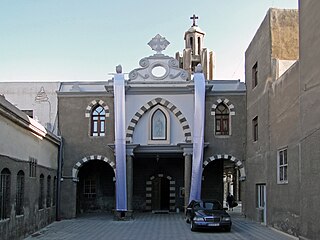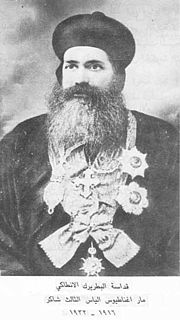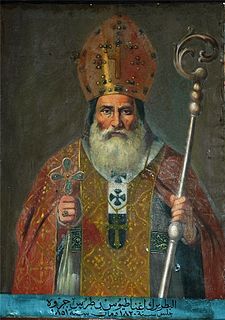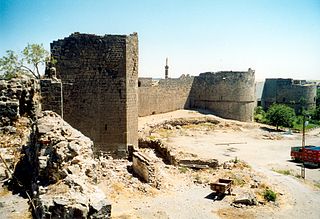
The Syriac Catholic Church is an Eastern Catholic Christian originating in the Levant that uses the West Syriac Rite liturgy and has many practices and rites in common with the Syriac Orthodox Church. Being one of the twenty-three Eastern Catholic Churches, the Syriac Catholic Church is a self-governed sui iuris particular church church while it is in full communion with the Holy See and entirety of the Catholic Church.

Ignatius Basile Moses I Daoud was Patriarch of Antioch for the Syrian Catholic Church, a Cardinal Bishop, and Prefect of the Congregation for the Oriental Churches in the Catholic Church.

Mor Hananyo Monastery is an important Syriac Orthodox monastery. The monastery is located in the Syriac cultural region known as Tur Abdin, and is located three kilometers south east of Mardin, Turkey.

Saint Ignatius Elias III was the Patriarch of Antioch, and head of the Syriac Orthodox Church from 1917 until his death in 1932.

Moran Mar Ignatius Abded Aloho II Sattuf also Ignatius Abdullah ll Stephan was the Patriarch of Antioch, and head of the Syriac Orthodox Church from 1906 until his death in 1915.
Ignatius Niʿmatallah was the Patriarch of Antioch and head of the Syriac Orthodox Church from 1557 until his resignation in 1576.

Moran Mor Ignatius Peter IV, also known as Ignatius Peter III, was the Patriarch of Antioch, and head of the Syriac Orthodox Church from 1872 until his death in 1894. He is regarded by many as the architect of the modern church.
Ignatius Isaac II was the Patriarch of Antioch and head of the Syriac Orthodox Church from 1709 until his resignation in 1723.
Ignatius Behnam Hadloyo was the Patriarch of Antioch and head of the Syriac Orthodox Church from 1445 until his death in 1454.
Ignatius John XIV bar Shay Allah was the Patriarch of Antioch, and head of the Syriac Orthodox Church from 1483 until his death in 1493.
Ignatius Jacob I, also known as Jacob al-Khuri or Jacob of al-Nabk, was the Patriarch of Antioch and head of the Syriac Orthodox Church from 1510/1512 until his death in 1517/1519.
Ignatius Noah of Lebanon, also known as Nūḥ Pūnīqoyo or Nūḥ al-Bqūfānī, was the Patriarch of Antioch and head of the Syriac Orthodox Church from 1493/1494 until his death in 1509.
Andreas Masius was a Catholic priest, humanist and one of the first European syriacists.

Mar Ignatius Peter VII Jarweh was Patriarch of the Syriac Catholic Church from 1820 to 1851.
Mar Ignatius Antony I Samheri, a converted bishop from the Syriac Orthodox Church, was Patriarch of the Syriac Catholic Church from 1853 to 1864.

Chaldean Catholic Eparchy of Seert was a diocese of the Chaldean Catholic Church, centered in Seert. It existed during the eighteenth, nineteenth and early-twentieth centuries. The diocese was ruined during the First World War.
Mardin was a diocese of the Chaldean Church from the sixteenth to the twentieth century. The diocese lapsed in 1941. Prior to this, it was a diocese of the Assyrian Church of the East, from which the Chaldean Catholic Church originated.

The Diocese of Amid (Diyarbakir) was a diocese or archdiocese of the Chaldean Church from the sixteenth to the twentieth century. From at least the 13th century the city of Amid had been part of the Diocese of Maiperqat of the Church of the East; following the schism of 1552 it became the seat of its own diocese in the Chaldean Church.
The schism of 1552 was an important event in the history of the Church of the East. It divided the church into two factions, of which one entered into communion with Rome becoming part of the Catholic Church at this time and the other remained independent until the 19th century. Although the Eliya line, which emerged as a result of this schism, did eventually enter into communion with Rome, various Eastern Protestant sects with their origins in the Church of the East emerged as a result of this schism. The Shimon line whose entry into full communion with Rome caused this schism became independent again by the 17th century. The circumstances of the 1552 schism were controversial at the time and have been disputed ever since.
Sarkis Rizzi, or Sarkis el-Rizzi was a Lebanese Maronite bishop. On his initiative, he was the first clergyman to print of a book in an Arab country.








